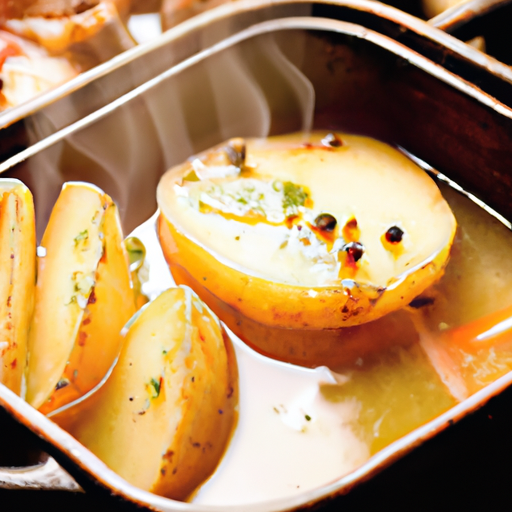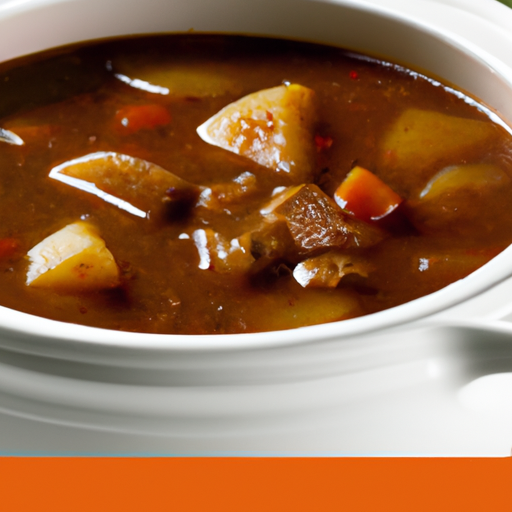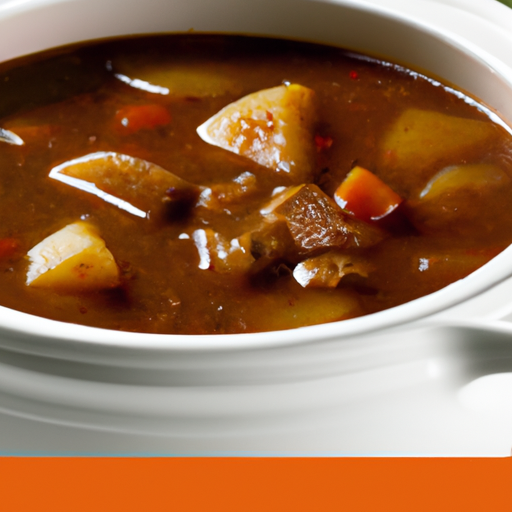If you’ve ever wanted to master the art of slow cooking, look no further. The “Ultimate Slow Cooking Guide” is here to revolutionize your kitchen experience. With its comprehensive slow cooking chart, this guide will teach you everything you need to know to create mouthwatering, tender dishes that will impress your family and friends. From savory stews to fall-off-the-bone ribs, this guide has you covered with foolproof cooking times and techniques. Say goodbye to burnt dinners and hello to culinary perfection with the “Ultimate Slow Cooking Guide”.

Choosing the Right Slow Cooker
When it comes to choosing the right slow cooker, there are a few factors you need to consider. One of the most important considerations is the size of the slow cooker. If you’re cooking for a small family or just yourself, a smaller slow cooker will suffice. However, if you often entertain guests or enjoy batch cooking, a larger slow cooker is a better option. It’s essential to choose a size that suits your needs to ensure you can cook the right amount of food without overcrowding or wasting space.
Another factor to consider is the shape of the slow cooker. Slow cookers come in different shapes, such as oval and round. Oval-shaped slow cookers are perfect for cooking larger cuts of meat and whole chickens, while round ones are better for soups, stews, and casseroles. Think about the type of dishes you’ll be preparing most often when deciding on the shape of your slow cooker.
Finally, checking the features of a slow cooker is crucial. Look for programmable timers, temperature settings, and keep-warm functions. Some slow cookers even have a sauté setting, which allows you to brown meat directly in the slow cooker. These additional features can enhance the versatility and convenience of your slow cooker, so choose one that suits your cooking style.
Essential Slow Cooking Techniques
To make the most delicious slow-cooked meals, you’ll need to master some essential techniques. One technique to familiarize yourself with is searing the meat before adding it to the slow cooker. Searing locks in the juices and adds a beautiful caramelized crust to the meat. Simply heat some oil in a skillet and brown the meat on all sides before transferring it to the slow cooker.
Layering ingredients is another technique that helps to ensure even cooking and flavors. Start with the meat as the bottom layer, followed by root vegetables, and finish with more delicate vegetables and herbs. This layering technique allows the meat to cook evenly and infuses the flavors throughout the dish.
The liquid ratio is crucial in slow cooking. It’s important not to drown your ingredients in liquid, as slow cookers are designed to retain moisture. Typically, recipes call for just enough liquid to cover the meat and vegetables, and the slow cooker will work its magic to create a flavorful sauce. However, always follow the recipe guidelines for liquid measurements to achieve the best results.
Must-Have Slow Cooker Accessories
While a slow cooker alone can create fantastic meals, there are a few accessories that can enhance your slow cooking experience. One essential accessory is a temperature probe. This handy tool allows you to check the internal temperature of your meat without removing the lid. It ensures that your meat is cooked to the desired doneness and prevents overcooking.
Slow cooker liners are another must-have accessory. These disposable liners make cleanup a breeze by preventing food from sticking to the pot. They save you valuable time and effort by eliminating the need to scrub the pot after each use.
Silicone lids are a fantastic accessory for slow cookers, especially if you plan to transport your cooked meals. These lids provide a tight seal, preventing any spills or leaks during transportation. They also help to retain heat and moisture, ensuring that your food stays fresh and delicious until you’re ready to serve.
Preparing Ingredients for Slow Cooking
Properly preparing your ingredients is essential for achieving the best results in slow cooking. When it comes to meat, trim any excess fat or skin before adding it to the slow cooker. This will prevent your dish from becoming greasy or overly fatty. Season the meat with your desired spices and herbs, or marinate it overnight to enhance the flavor.
Chopping vegetables into uniform sizes is important for even cooking. Larger pieces will take longer to cook, while smaller ones may become mushy. Aim for bite-sized pieces that will cook evenly throughout the cooking process. Additionally, vegetables that release a lot of moisture, such as zucchini or mushrooms, should be added closer to the end of the cooking time to avoid excess liquid in your dish.
If you’re using beans or lentils in your slow cooker recipes, soaking them beforehand is highly recommended. Soaking helps to soften the beans and reduces the cooking time. Simply cover the beans or lentils with water and let them soak overnight. Before adding them to the slow cooker, drain and rinse them thoroughly.

Choosing the Right Cuts of Meat
Selecting the right cuts of meat is essential for achieving tender and flavorful results in slow cooking. For braising, tougher cuts of meat with more connective tissue, such as chuck roast or short ribs, are ideal. These cuts benefit from the long cooking time and low heat, which breaks down the collagen and transforms them into deliciously tender and moist dishes.
If you’re looking for healthier options, lean cuts of meat are perfect for slow cooking. Lean cuts like chicken breasts, pork tenderloin, or lean beef cuts are lower in fat but still yield incredible results. Just be mindful of the cooking time, as lean cuts can become dry if overcooked.
There are plenty of popular meat options for slow cooking. Chicken thighs are incredibly versatile and work well with various flavors and cuisines. Pork shoulder or butt is another great option, especially for pulled pork or carnitas. And if you’re a fan of beef, brisket or stewing beef are excellent choices for hearty and satisfying meals.
Creating Flavorful Slow Cooker Recipes
Slow cooking is not only convenient but also an excellent way to infuse your dishes with incredible flavor. One way to spice up your slow cooker recipes is by using herbs and spices. Whether it’s a simple combination of salt, pepper, and garlic powder or a complex blend of exotic spices, herbs and spices can elevate the taste of your dish. Experiment with different combinations to find your favorite flavors.
Don’t be afraid to get creative with the liquids in your slow cooker recipes. While broths and stocks are commonly used, you can also try using wine, beer, or even fruit juices for added depth of flavor. The slow cooking process will meld the flavors together beautifully, resulting in a rich and delicious sauce.
Adding aromatics, such as onions, garlic, or ginger, can take your slow cooker dishes to the next level. These aromatic ingredients infuse your entire dish with a depth of flavor that is hard to achieve with other cooking methods. Sauté them in a skillet before adding them to the slow cooker to release their full potential.
Adapting Traditional Recipes for Slow Cooking
If you have favorite traditional recipes that aren’t originally designed for slow cooking, don’t worry! You can easily adapt them to work with your slow cooker. The first step is to adjust the cooking times and temperatures. Slow cookers operate at low temperatures, so you’ll need to increase the cooking time to achieve the desired doneness. As a general rule, every hour of conventional cooking at high heat is equal to 4 to 6 hours on low in a slow cooker.
Modifying ingredient quantities is another crucial step when adapting traditional recipes. Due to the long cooking times, flavors may become more concentrated, so you may need to reduce the amount of salt or spices. You may also need to adjust the amount of liquid used, as slow cookers retain moisture exceptionally well.
If your recipe calls for browning the ingredients before cooking, there are alternative techniques you can use in your slow cooker. Some slow cookers have a sauté function, allowing you to brown the ingredients directly in the pot. If your slow cooker doesn’t have this feature, you can use a separate skillet on the stovetop to brown the meat and sauté the vegetables before transferring them to the slow cooker.
Tips for Cooking Vegetarian and Vegan Dishes in a Slow Cooker
Slow cookers are not just for meat lovers – they are also fantastic for vegetarian and vegan dishes. When cooking vegetarian or vegan meals, it’s essential to choose protein-rich ingredients. Legumes, such as beans, lentils, chickpeas, or tofu, are excellent sources of protein and can be the star of your dish. Ensure that they are cooked properly by following the recipe instructions and adjusting the cooking time accordingly.
Optimizing vegetable texture is crucial when cooking vegetarian dishes in a slow cooker. Some vegetables need more time to soften and release their flavors, while others can become mushy if overcooked. Consider adding sturdier vegetables, like carrots or sweet potatoes, earlier in the cooking process and delicate vegetables, such as spinach or peas, towards the end.
When it comes to flavors, don’t hesitate to get creative. Experiment with different spices, herbs, and vegetable combinations to create delicious and unique vegetarian or vegan dishes. The slow cooking process allows the flavors to develop and meld together, resulting in a depth of taste that will satisfy even the most discerning palate.
Food Safety Considerations for Slow Cooking
While slow cooking is a convenient and easy way to prepare meals, it’s essential to follow food safety guidelines to prevent any risks. Proper handling of raw ingredients is crucial to avoid cross-contamination. Always wash your hands before and after handling raw meat or vegetables. Use separate cutting boards and utensils for raw meat and vegetables to prevent any potential bacterial contamination.
Avoiding overcooking or undercooking is key to ensuring the safety of your slow-cooked meals. Follow the recommended cooking times and temperatures provided in the recipe. If unsure, use a food thermometer to check the internal temperature of the meat. For most meats, the minimum safe temperature is 145°F (63°C), but some tougher cuts may need to be cooked to higher temperatures for tenderness.
Storing leftovers safely is essential to prevent foodborne illnesses. Divide any leftover food into small, shallow containers to allow for faster cooling. Store the leftovers in the refrigerator within two hours of cooking. It’s best to consume the leftovers within three to four days, but if you can’t finish them in time, you can freeze them for later use. When reheating, ensure that the food reaches a temperature of at least 165°F (74°C) to eliminate any harmful bacteria.
Troubleshooting Common Slow Cooking Issues
While slow cooking is generally a straightforward process, some common issues can occur. Excessive liquid in the dish can be a problem in some slow cooker recipes. To reduce the liquid, you can try removing the lid during the last hour of cooking to allow some of the moisture to evaporate. Alternatively, you can thicken the sauce by mixing cornstarch with water and adding it to the slow cooker. Let the sauce simmer for a few minutes to thicken.
If you find that your meat is becoming dry or tough, it may be overcooked. Check the internal temperature of the meat and ensure that it has reached the desired doneness. Sometimes, adding more liquid or turning the heat to low can help to retain moisture and prevent dryness. Consider using cuts of meat with more marbling or connective tissue, as they will generally result in more tender and juicy dishes.
Burnt or stuck-on food can be frustrating, but there are ways to avoid this issue. Make sure to grease the slow cooker with cooking spray or oil before adding your ingredients. Layer root vegetables or a bed of onions at the bottom of the pot to prevent the meat from sticking. If you notice food sticking during cooking, avoid scraping it off, as this can damage the pot’s non-stick surface. Instead, soak the pot in warm, soapy water to loosen the stuck-on food before cleaning it.
Now that you have a comprehensive understanding of slow cooking, it’s time to grab your slow cooker and get cooking! With the right equipment, techniques, and knowledge, you’ll be able to create flavorful and nutritious meals that will wow your family and friends. So go ahead, embrace the art of slow cooking, and enjoy the delicious results it brings to your table.
